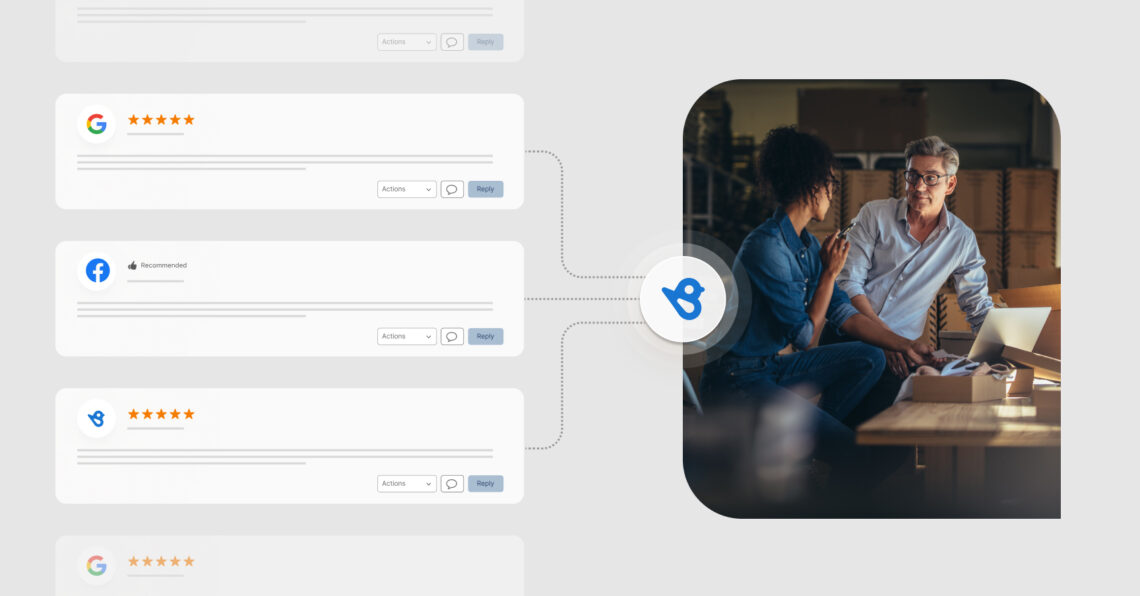Online reviews have rapidly become the top source of new leads, with 34% of marketers citing them as the number one channel for customer acquisition. And that’s just scratching the surface of their potential – one Birdeye’s latest data report found that 92% of consumers read at least two reviews before deciding whether to trust a business.
As customers, we all check online reviews before booking a hotel, trying a new restaurant, or buying a high-ticket item. In fact, recent Birdeye research revealed that:
- 68% of consumers check online reviews for a business before choosing a brand or service provider.
- 80% of consumers are more likely to choose a business that responds to reviews.
- 78% of consumers mention that they are unlikely to choose a business with a poor online reputation.
- 50% of consumers read at least five reviews before choosing a business, and this could be across various review sites and forums.
Clearly, online reviews significantly influence consumer decision-making, and businesses need an active review management strategy to be on top of their review monitoring efforts.
In this blog post, we’ll cover everything you need to know to get review monitoring right, from expert tips and best practices to the most effective tools to help your business thrive.
Table of contents
- What is review monitoring?
- Why is it essential to monitor and track online reviews?
- 1. Enhance customer experience and improve customer retention rate
- 2. Understand market sentiment and brand perception
- 3. Handle negative reviews to improve online reputation
- 4. Improve review quality by reporting fake and spam reviews
- 5. Rank higher for local searches
- 6. Improve lead generation and conversion rates
- 5 tips for acing review monitoring and managing
- How to choose the best review monitoring tool for your business?
- Top 16 review monitoring tools
- Frequently asked questions about review monitoring
- Monitor your reviews with Birdeye – the top-rated review and reputation management platform
What is review monitoring?
Review monitoring is the process of tracking, monitoring, and analyzing online customer reviews about a brand on popular channels such as Google, Facebook, and other industry-specific review sites.
It involves monitoring brand mentions, negative reviews, positive reviews, customer feedback, ratings on review sites, and more. Monitoring customer reviews and feedback can help businesses gauge market sentiment, understand potential issues, manage online reputation, and improve customer experience.
Why is it essential to monitor and track online reviews?
Review monitoring helps businesses improve customer experience, handle negative reviews, and identify and report fake/spam reviews. Additionally, tracking recurring trends in reviews allows companies to uncover customer needs and dramatically boost lead generation and conversion rates.
The top benefits of review monitoring include:
- Enhance customer experience and improve customer retention rate
- Understand market sentiment and brand perception
- Handle negative reviews to improve online reputation
- Improve review quality by reporting fake and spam reviews
- Rank higher for local searches
- Improve lead generation and conversion rates
Let’s explore the benefits in detail.
1. Enhance customer experience and improve customer retention rate
Birdeye’s research indicates that 38% of customers who have a negative experience with a business are likely to leave a review. These customers often move on to competitors after leaving a review. However, you can change this with the right approach and tools. However, you can change this by proactively monitoring online reviews and taking appropriate action.
Businesses that invest in online review monitoring can:
- Quickly identify customer pain points
- Reach out to the customer
- Turn that negative review into a positive customer experience
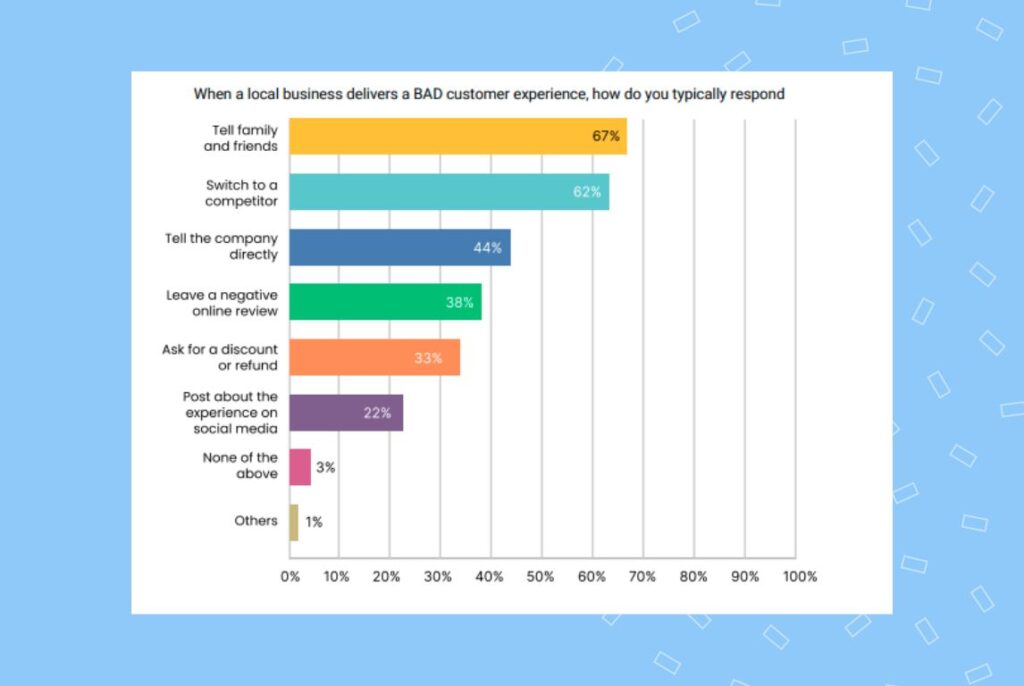
This will help retain that customer and improve the overall customer experience.
2. Understand market sentiment and brand perception
Monitoring and analyzing customer reviews across platforms can help you better understand brand perception, market sentiment, and positioning. While businesses usually hire data analysts and external consultants, they can also turn to customers and know directly from reviews about business performance.
Recurring keywords, phrases, and overall sentiment in reviews (positive or negative) can effectively guide business decisions.
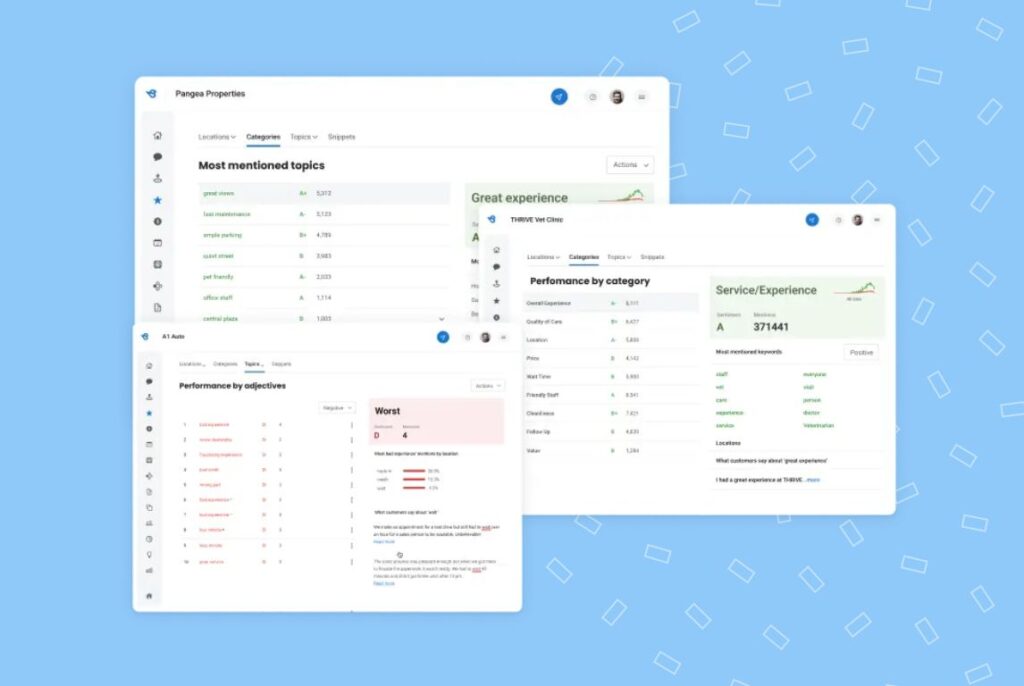
3. Handle negative reviews to improve online reputation
Business owners can only solve a problem when they know about its existence. Most businesses come to know about negative reviews only when they run PR campaigns or when potential customers point them out. This does not bode well for the business.
Monitoring reviews helps you flag negative brand/product reviews, respond quickly, and solve the issue immediately. This has a profound impact on your online reputation.
Additionally, proactive review monitoring ensures your team is aware of the latest customer feedback and can confidently address any concerns during sales discussions.
4. Improve review quality by reporting fake and spam reviews
Not all negative reviews are genuine. Most businesses face the challenge of ongoing spam reviews or fake reviews left by bots or competitors. With efficient online review tracking, you can instantly report them and improve the quality of your reviews.
Removing fake and spam reviews ensures that your potential customers see an accurate depiction of your business.
5. Rank higher for local searches
Review quality, review volume, and the recency of reviews are important factors in determining your local search ranking. Monitoring online reviews can help you understand where you stand across different channels. Your business can then run appropriate campaigns to generate more reviews wherever needed and boost local search rankings.
6. Improve lead generation and conversion rates
A recent Birdeye survey shows that over 85% of consumers choose to refrain from engaging with a local business if they have negative reviews. Not dealing with negative product reviews can profoundly impact your lead generation and conversion rates.
With review monitoring tools like Birdeye, you can instantly resolve customer issues, request them to remove the review, or post an update on the resolution of the issue. This way, potential customers know you are an accountable business, and your team can persuade them to engage with you.
“We don’t have time to monitor all the multiple platforms we use to engage with our customers, so Birdeye has been a valuable tool for monitoring reviews and sending review requests. It’s vital to request reviews through different methods because it gives people more opportunity to leave feedback. The only way to grow your business is by learning what you are doing well and what needs improvements.”
Heather Schwenk, Missoula Property Management LLC
5 tips for acing review monitoring and managing
To maximize the benefits of review monitoring for your business, it is important to streamline your approach. This means covering all your bases: tracking reviews across multiple locations, setting up your online profiles, scanning social media, and so on.
Here are our top tips to streamline review monitoring and stay on top of customer sentiment:
1. Identify top review sites
The idea of review monitoring is overwhelming in the beginning because businesses usually focus on all the review sites at once. But here’s the good news: customers aren’t scattered across every platform. Our studies reveal that most customers focus only on a few core sites like Google, Apple, Bing, Facebook, and other niche-specific sites.
Therefore, you should streamline your process and focus on the big ones instead of overextending resources monitoring 100+ sites.
2. Go beyond traditional review sites
While we expect them to, customers don’t always stick to the authorized forums to talk about a business. They use social media platforms, online forums, blogs, emails, and more to share their experience.
It is important for a business to incorporate these offbeat channels into their review monitoring process to fully capture consumer sentiment.
3. Set up notifications
Ensuring you never miss a review or comment is the very basic tenet of review monitoring. However, it is easier said than done. Businesses starting out with manual review monitoring and managing processes should start by setting up notifications, email alerts, and more. This way, you have a record of every review that goes live and you can tackle them one by one.
Or, you can streamline the process and work with a review monitoring tool like Birdeye that automates notifications, records all reviews, and allows you to track from a centralized dashboard.
4. Claim business profiles
Managing your reviews is the essential flip side of the review monitoring coin. Managing is what makes the monitoring worthwhile. However, businesses can’t respond, report, or block a customer review (if necessary) without claiming the profile on the respective review site.
Claiming the business profile also allows you to edit business information, avoid any misinformation, and take charge of your online presence.
5. Focus on analytics
You can take your review management campaign a notch above by going beyond just monitoring reviews and handling them as they go. Businesses need a strategy that allows them to shore up their online reputation.
And that comes from using a review monitoring tool that provides in-depth insights to customer behavior, trending topics in reviews, average rating for multiple locations, and more.
How to choose the best review monitoring tool for your business?
Manual review monitoring leaves room for errors and that’s why it is important for growing businesses to employ the best review monitoring tool for their reputation management. The ideal review monitoring tool helps you track reviews across platforms with real-time notifications, provides in-depth analytics, and aids in managing reviews comprehensively.
Critical factors to consider while choosing a review monitoring tool are:
- Review sourcing platforms
- Reporting and analytics
- Review response features
- Collaboration features
- On-the-go/real-time notifications
- Automation
Let’s explore them in detail so that you can make an informed decision.
1. Review sourcing platforms
This is one of the most essential and distinguishing features to help you choose the right review monitoring tool.
Every industry has a few essential global and niche-specific review sites that it needs to monitor. The tool you choose must support the review platforms you have a strong presence on.
Carefully check if the tool you choose can source reviews from those platforms before deciding.
2. Reporting and analytics
Monitoring reviews won’t help you understand customer sentiment or outshine your competitors without robust reporting features.
Businesses need visualized analytics, robust reporting models, and insights that can help them make sense of the vast data collected from customer reviews and social media conversations.
Review monitoring tools that double as Google review analyzer, product review monitoring tools, and brand perception analyzes can come in handy.
Choose a review monitoring tool that allows you to customize reports, build custom dashboards, and analyze as many keywords/categories as needed.
3. Review responses
Responding to reviews instantly helps businesses improve their online reputation, local search ranking, and customer satisfaction. It is a critical part of the review management process.
Businesses can greatly benefit by choosing a review monitoring tool that allows you to respond to customer reviews right from the dashboard instantly. This saves time and improves productivity by not having to click hundreds of individual links.

Choose integrated solutions like Birdeye that help businesses respond to reviews directly from the dashboard, set up response templates, use AI to craft/proofread review responses, translate reviews from other languages, and make overall review management easy.
4. Collaboration features
Review monitoring is a complex and resource-intensive process. Businesses need all team members invested in monitoring reviews, responding to them, flagging issues, and raising tickets for best results.
And that is why collaboration features are essential in review monitoring tools. The best tool is the one that allows you to add users, give them varying permissions, and allow them to accelerate review management.
5. On-the-go/real-time notifications
Review monitoring is not a process where you can just donate a few hours a week and expect great results. Constant monitoring and getting real-time alerts is critical for a successful review monitoring program.
Choose a tool that gives instant alerts when a customer adds a review, responds to your comment, or posts something online about your brand.
Review monitoring tools should allow you to get notifications via desktop apps, mobile apps, emails, and SMS channels for the best coverage.
6. Automation
Lastly, automation features in a review monitoring tool significantly enhance the review monitoring process. Some of the key automation features to consider include automated keyword tracking, alerts for negative reviews, review responses, and automated ticket creation.
Top 16 review monitoring tools
Every business needs to invest in review monitoring, irrespective of its size. While you can monitor online reviews manually, it becomes challenging to do it effectively for a more extended period.
Here are some of the top review monitoring tools you can explore for your business:
- Birdeye
- Google Alerts
- ReviewPush
- Reputation
- SOCi
- ReviewShake
- Appbot
- Reviewtrackers
- ReviewBot
- Mention
- Reviewflowz
- Grade.us
- Chatmeter
- Review Monitoring
- Mentionlytics
- Hootsuite
Let us explore these online review monitoring services to help you choose the best one for your business.
1. Birdeye
Birdeye leads the industry as the top-rated reputation management platform for multi-location businesses and the most-awarded Experience Marketing software worldwide. Recently we were honored by G2 as one of the top 50 Customer Service products and a leader in Online Reputation Management.
Birdeye specializes in review management, listing management, appointment scheduling, surveys, and social media management.
“Being able to monitor and respond to reviews appropriately in a timely manner through Birdeye is a game changer. The recommended AI responses are definitely helpful when we’ve run out of ways to say thank you.”
Meghan Bingham, Valley Vet Care
Our review management feature especially allows businesses to generate, monitor, analyze & respond to, reviews across 200+ sites, including Google reviews, Facebook reviews, and so on.

Birdeye allows businesses to monitor online reviews for multiple locations and channels from a single dashboard.
With Birdeye’s review monitoring tool, you can:
- Respond to all reviews from the dashboard using pre-made templates.
- Set up auto-response templates for all reviews.
- Tag reviews as 1-star, team member assisted, and more for easy reporting.
- Use BirdAI to translate reviews and respond to customer reviews professionally.
- Understand market sentiment with AI-assisted review summaries.
- Report fake and spam reviews right from the dashboard.
- Analyze review ratings for each location.
- Evaluate performance with competitive benchmarking.
- Build a custom online review tracker for reports as per your business needs.
- Monitor customer sentiment with online review tracking, keyword tracking, and categories across review sites and social media platforms.
- Send unlimited review requests, provide access to individual users, and allow employees on the ground to send personalized requests.
- Identify the top-performing and least-performing business locations to take appropriate action.
You can also monitor social media conversations with Birdeye Social to know what customers post about your brand.
Excited to transform your business with Birdeye’s suite of solutions? Get started today – check out the pricing now.
Monitor, manage, and share reviews to grow your business.
Want to see the impact of Birdeye on your business? Watch the Free Demo Now.
2. Google Alerts
Google Alerts is a free online review monitoring service for businesses to monitor and track conversations around the brand. You can use this tool to track specific keywords and brand mentions online.
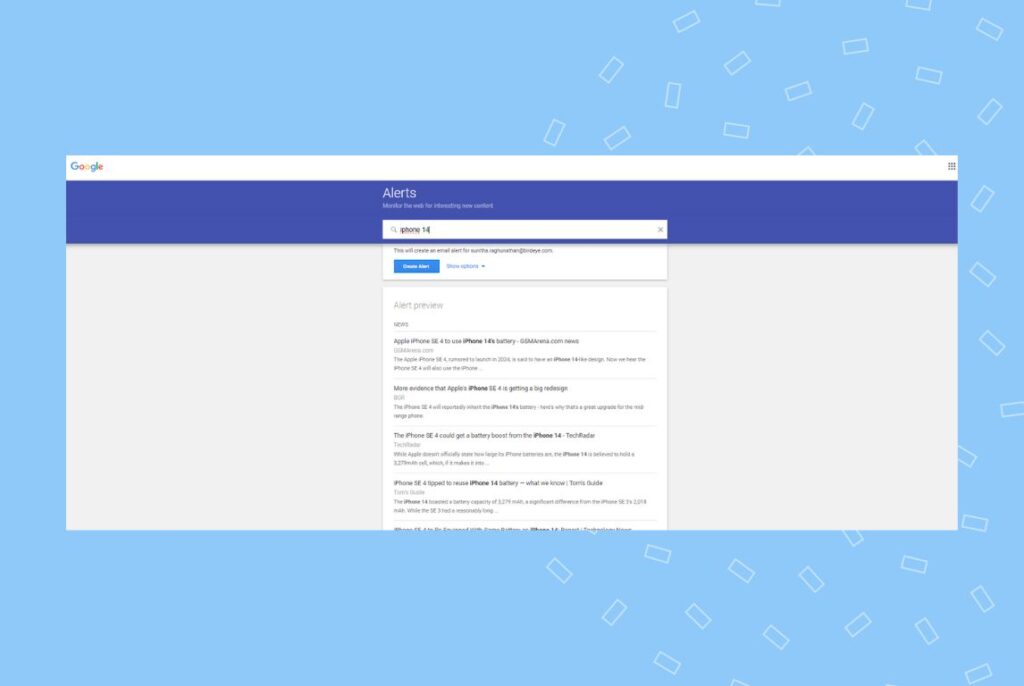
You can set up Google Alerts to receive notifications when online content mentions your business name, products, or other relevant keywords. However, Google Alerts does not directly monitor customer reviews across forums or Google Business listings.
While useful for basic brand monitoring, Google Alerts lacks robust capabilities to track online reputation across review sites. Businesses need a more comprehensive solution like Birdeye reviews to actively manage online reviews and understand direct customer feedback at scale.
3. ReviewPush
ReviewPush helps businesses collect, manage, analyze, and promote online reviews from its dashboard. The tool is mainly aimed at restaurants and hotels, directly connecting with the business’s POS (point of sale) software.
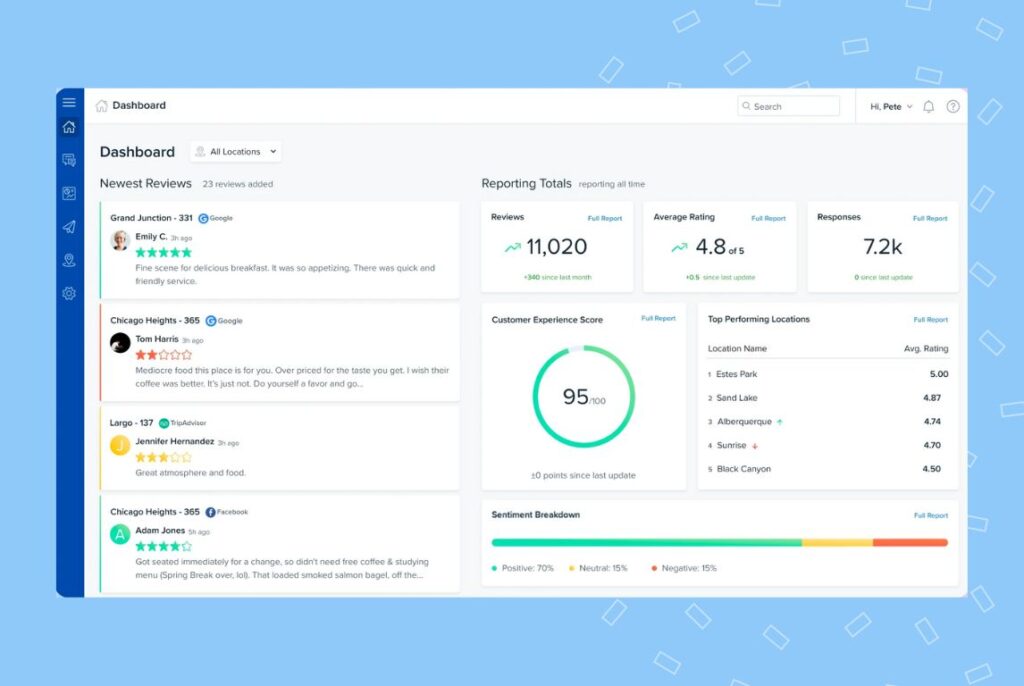
With ReviewPush, businesses can:
- Send review requests to their customers with a simple 5-star rating and free-form interface.
- Collect, track, and analyze customer reviews from ReviewPush’s dashboard.
- Monitor the latest reviews and respond to them to improve customer engagement.
- Track the mentions of various keywords to gauge market sentiment.
- Check the average rating of business across various forums.
4. Reputation
Reputation is a review monitoring tool that businesses can use to collect, monitor, and manage reviews on over 200 sites. With this tool, you can send review requests to customers via SMS, email, and surveys.
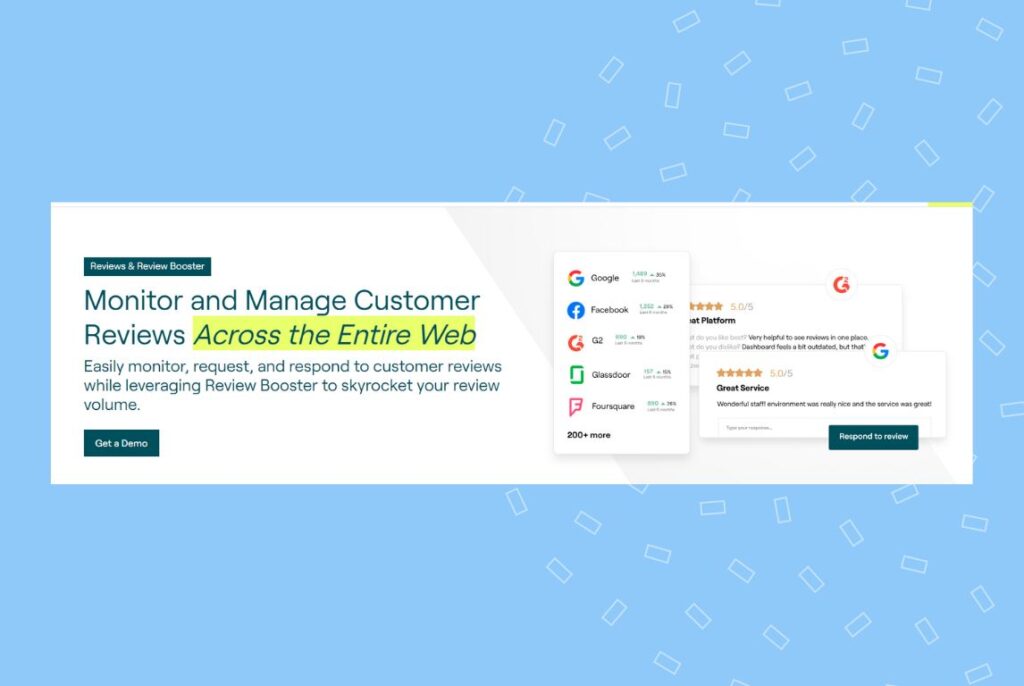
This tool allows businesses to:
- Monitor reviews and respond to them from Reputation’s dashboard.
- Identify positive reviews and promote them on your website and social media platforms.
- Turn survey feedback into online reviews.
- Monitor specific keywords, tags, and mentions to understand customer sentiment.
5. SOCi
SOCi is a review monitoring tool businesses can use to allow local teams to view, respond to, and manage online reviews across various forums.
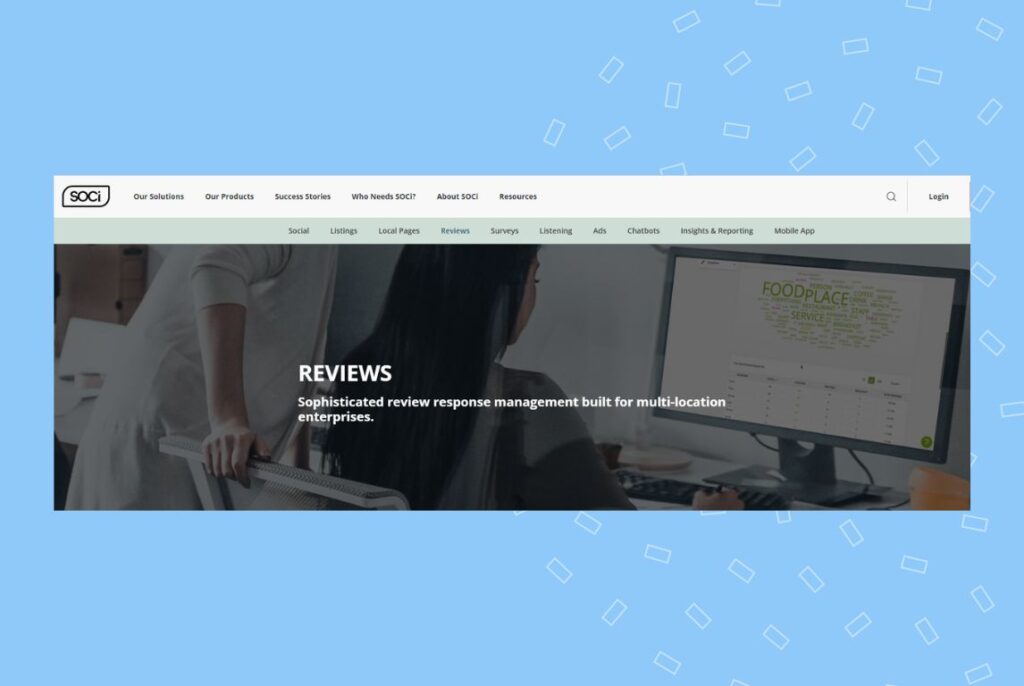
With this tool, businesses can:
- Empower local teams to receive real-time push or email notifications when a new review goes live. They can then respond to it instantly.
- Allow corporate teams to monitor the dashboard for online reviews, response times, and customer sentiment to gauge overall business performance.
- Use AI to generate professional review responses and create review response templates.
- Identify market sentiment and emerging trends by analyzing customer reviews across 20 key networks supported by SOCi.
6. Reviewshake
Reviewshake allows businesses to manage reviews on more than eighty-five review sites. You can send review requests to customers, respond to reviews, and get notifications when a customer leaves a review by email.
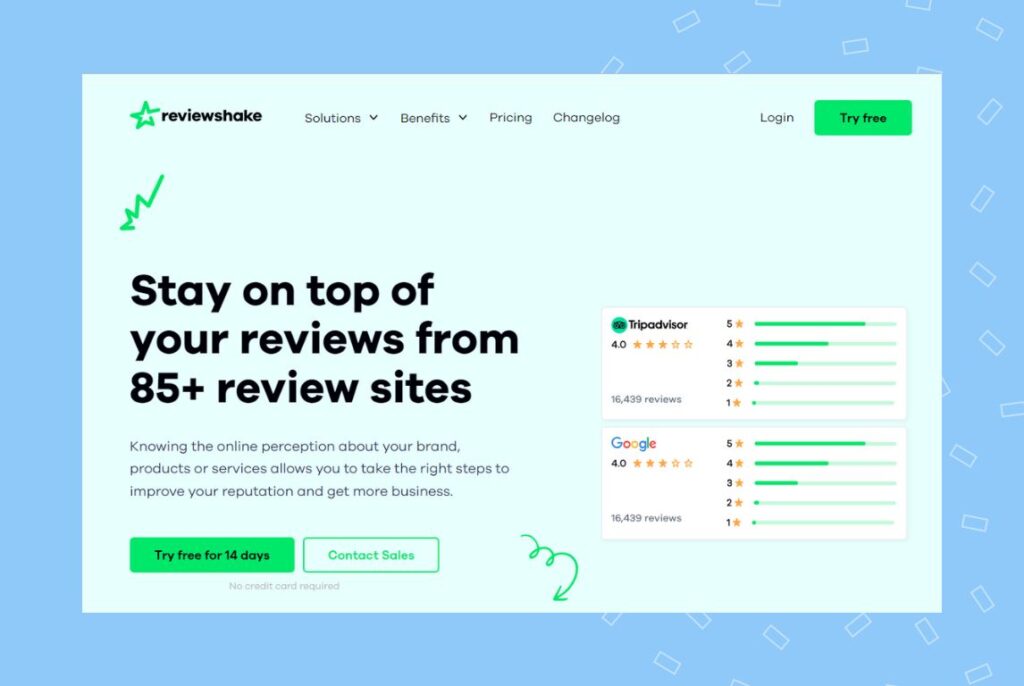
It is a handy tool but needs more sophisticated insights, reporting, and analysis features to maximize your review monitoring investment.
Businesses can use Reviewshake to:
- Manage reviews from popular review sites like Google, Facebook, and G2. They may not integrate with much more niche review sites for each industry.
- Know when a review comes in and respond to it instantly.
- Give access to individual users so that they can respond to reviews.
- Understand review volume by site, the success of review generation campaign success, and so on.
7. AppBot
AppBot is a review monitoring software specifically catering to businesses with a substantial presence on Amazon. The tool helps businesses track, manage, and analyze Amazon reviews.
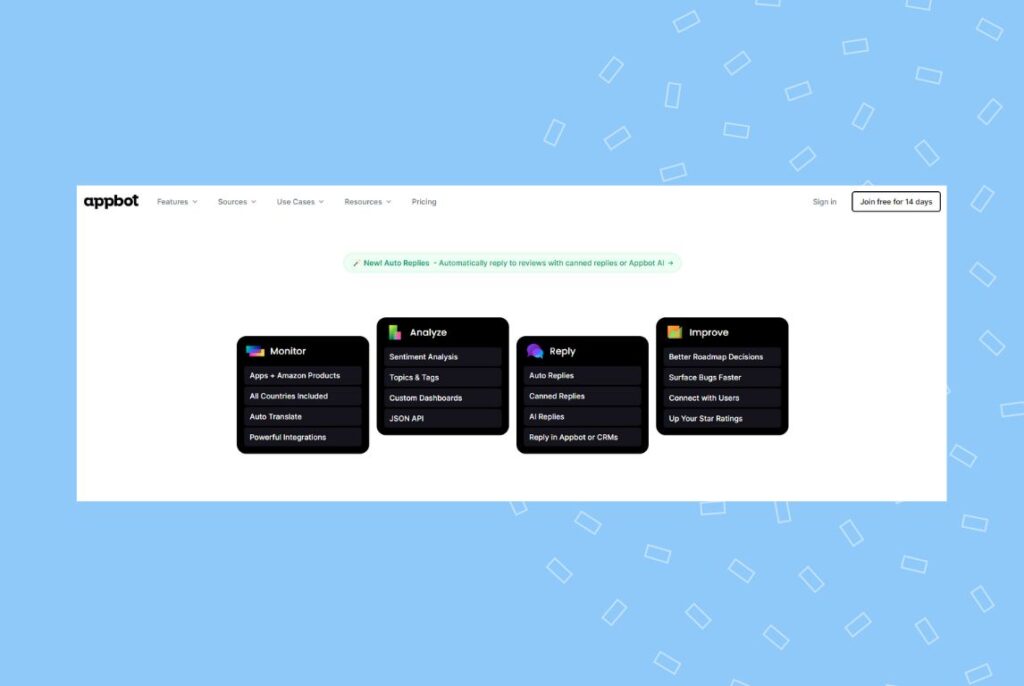
This tool is specific to mobile applications and can track online reviews on Amazon, App Store, and Google Play Store.
With this tool, businesses can:
- Reply to reviews directly from the tool’s dashboard.
- Set up automated and AI-generated review responses for customer reviews.
- Monitor, tag, and analyze Amazon reviews from all countries.
- Use AI to understand customer sentiment and trends, and improve ratings for your business.
8. ReviewTrackers
ReviewTrackers helps businesses monitor online business reviews on more than hundred sites and analyze the contents by selecting the required keywords.
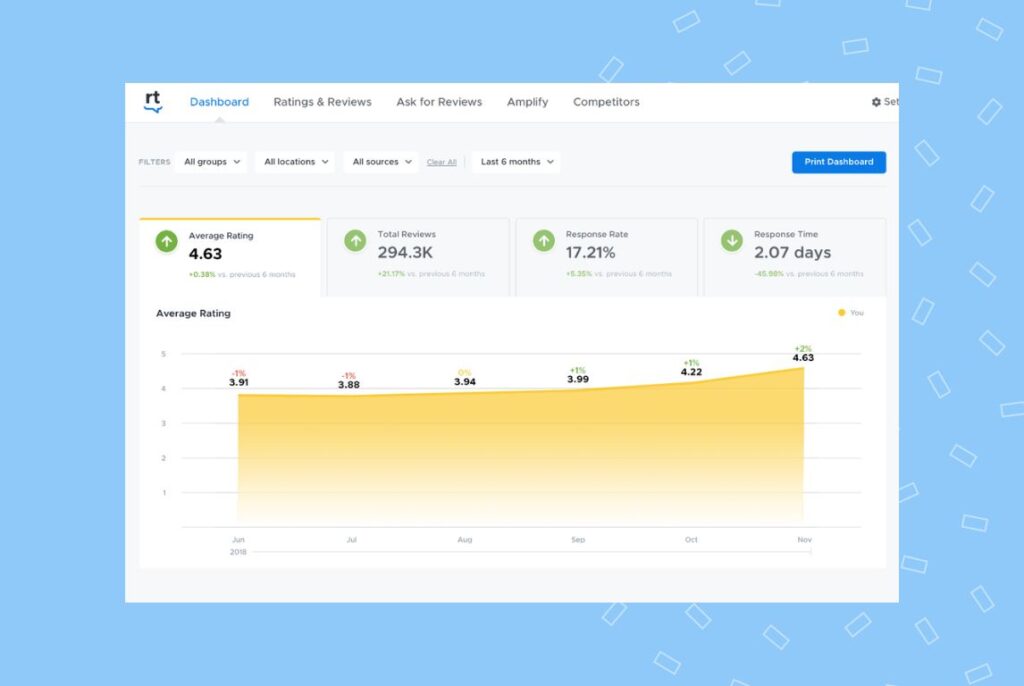
Some of the top features of this tool are:
- An easy-to-use user interface.
- The ability to invite teams for better collaboration.
- Competitor analysis features.
One of the significant drawbacks of this tool is that it does not allow businesses to respond to reviews directly from the tool dashboard. The reporting feature also needs an update to compete with industry standards.
9. ReviewBot
ReviewBot is a simplistic review monitoring software that businesses can use to primarily monitor their reviews and ratings on the iOS store, Google Play Store, Google, and other popular channels.
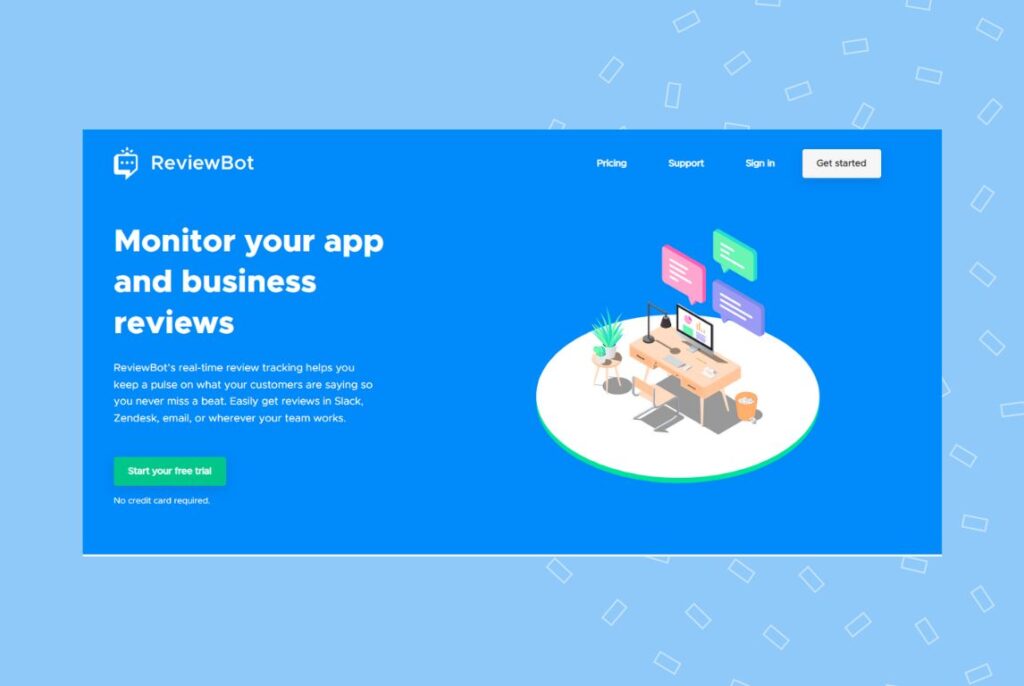
With this tool, you can:
- Set up flows or reports for each location or channel you wish to monitor your ratings.
- Integrate with Teams or Slack so your team members get notifications when a new review drops.
- Respond to customer reviews by clicking on the external link generated with each review. However, there is no facility to reply from the app directly.
- Monitor mentions of your brand, competitors, and specific keywords to analyze business performance.
10. Mention
Mention is another social monitoring tool businesses can use to track customer conversations, brand mentions, and trending topics relevant to their industry.
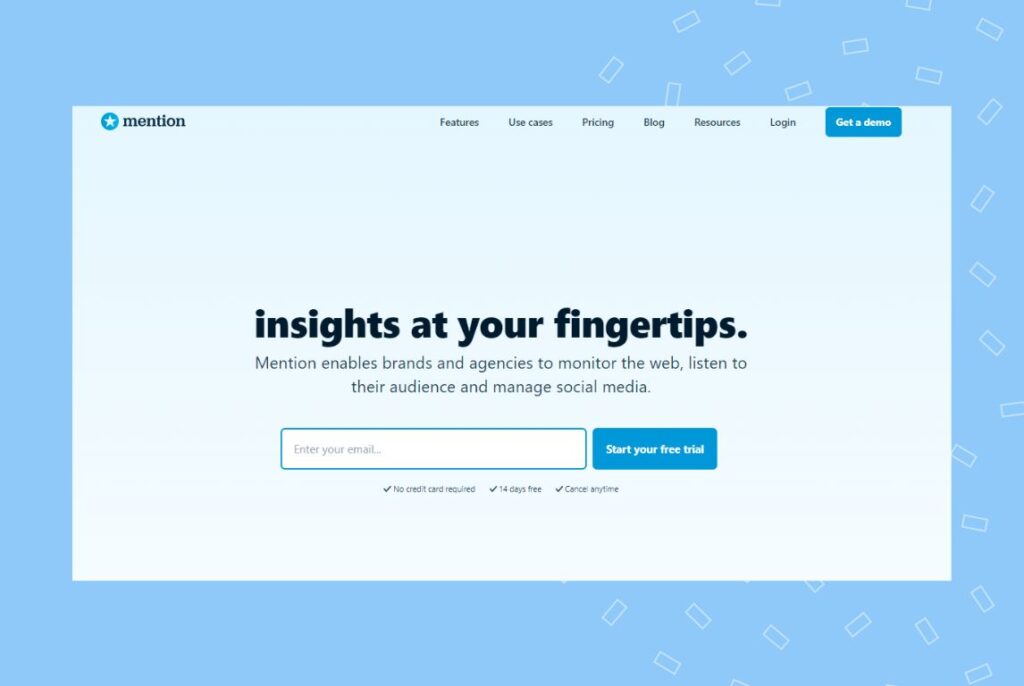
With this tool, you can:
- Set up campaigns to monitor brand mentions on social media, review sites, and online forums.
- Track specific keywords and web pages to stay on top of important topics.
- Autotag mentions, send assignments, and collaborate with your team members.
- Get alerts for every review and brand mention per your requirements on Slack or other custom channels.
11. Reviewflowz
Reviewflowz helps businesses monitor online reviews on public listing sites with a custom API. You can pull your reviews from Google, TrustPilot, G2, and various app stores.
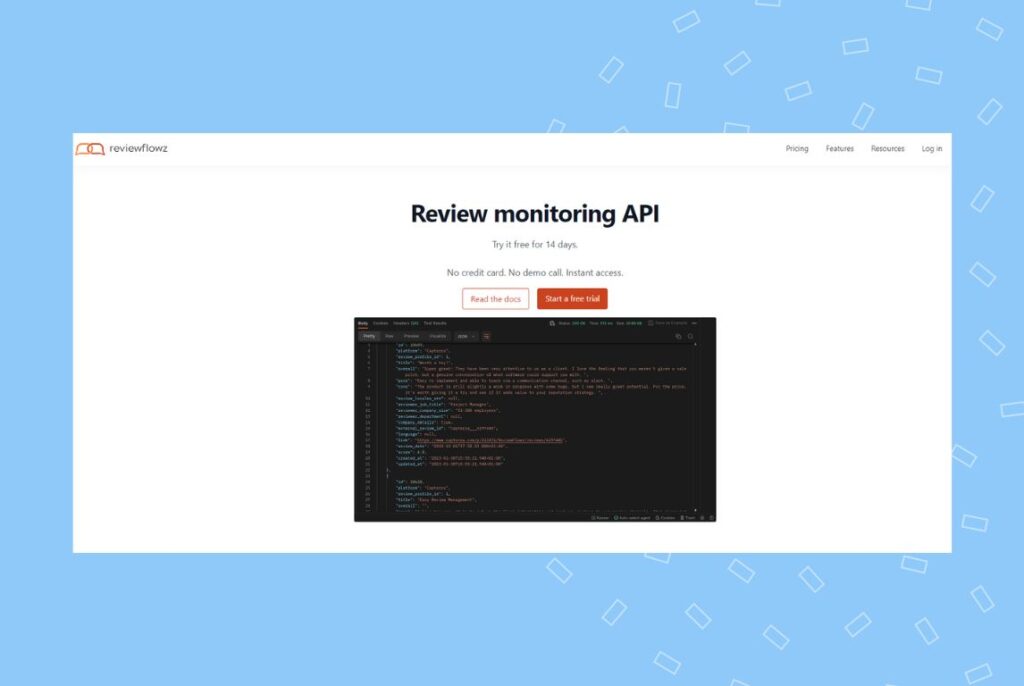
With this tool, you can:
- Monitor online reviews and create specific webhooks so that you can get notifications for each new review that comes in.
- Integrate Make.com, Zapier, and other tools to get your reviews ready to use in landing pages, design, and product marketing materials.
- Create dynamic review widgets that you can use to showcase specific reviews.
- Track online reviews for your competitors.
12. Grade.us
Grade.us is a review management tool that helps businesses monitor online reviews as part of their package. With this tool, you can monitor niche review sites and the most popular review sites for customer reviews.
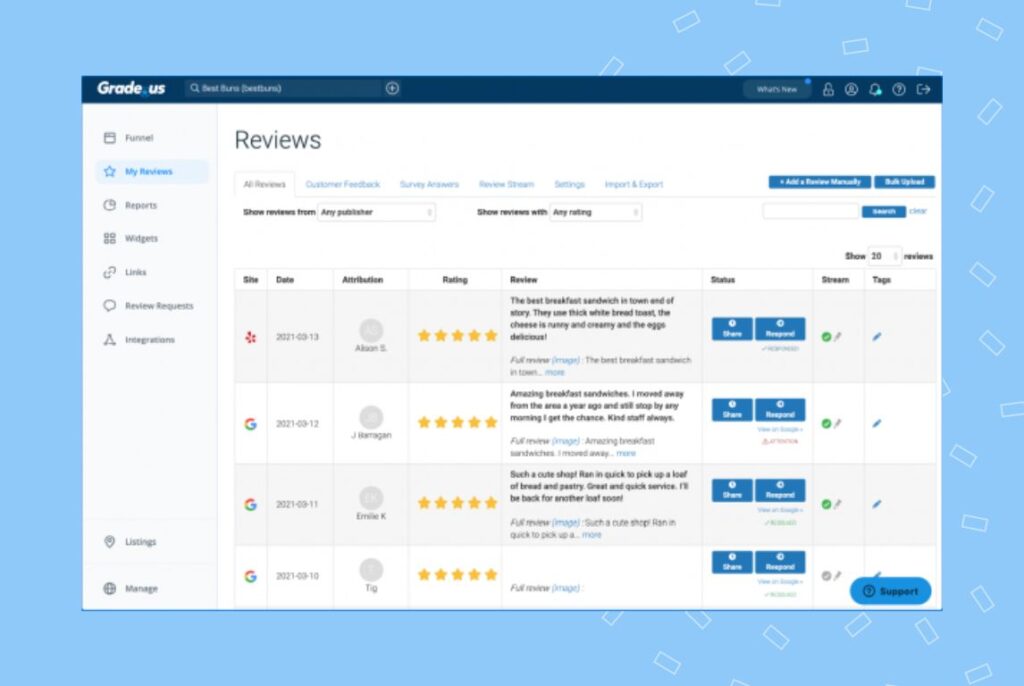
Some of the top features of this tool are:
- Email notifications to know when a new review drops in.
- Review response features that allow businesses to reply to positive and negative reviews with the tool.
- The ability to monitor online reviews from various sites from a centralized command center.
13. Chatmeter
Chatmeter is an online reputation monitoring tool that tracks brand mentions, customer sentiments, and online customer conversations.
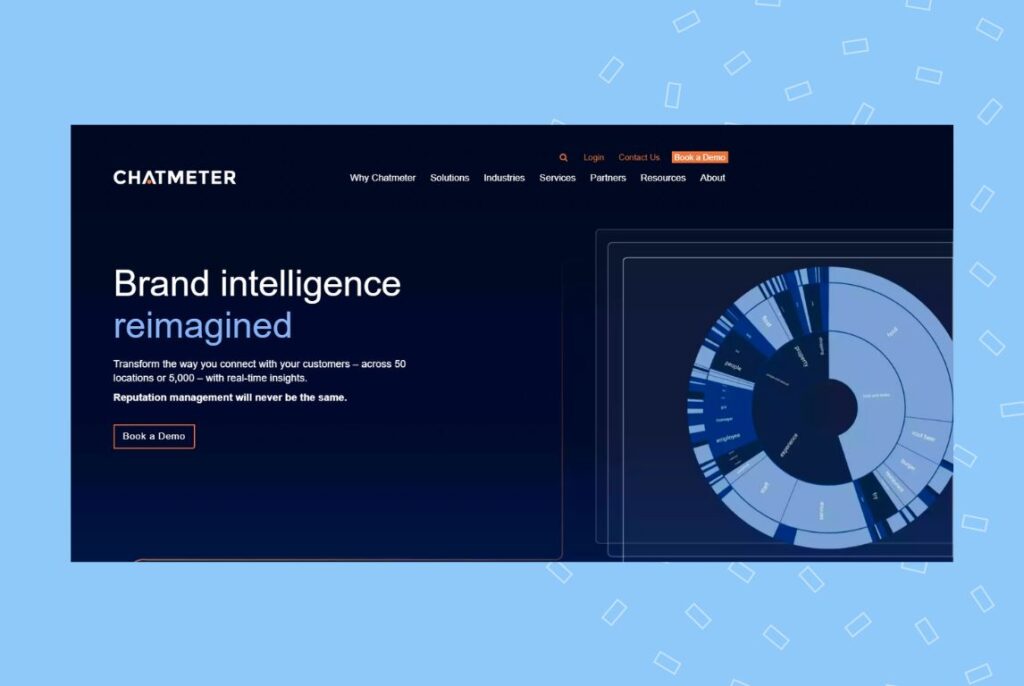
Some of the top features are:
- AI-generated review response templates that assist businesses to engage customers as needed.
- Customer sentiment visualization with data points from photos, comments, user-generated content, and customer reviews.
- Performance analysis tools that help you benchmark results against competitors.
14. Review Monitoring
Review Monitoring is an automated review monitoring and analysis tool for e-commerce sites.
This tool lets you chat with an AI to gain insights from your customer reviews. With it, you understand various data points and know what works for your business.
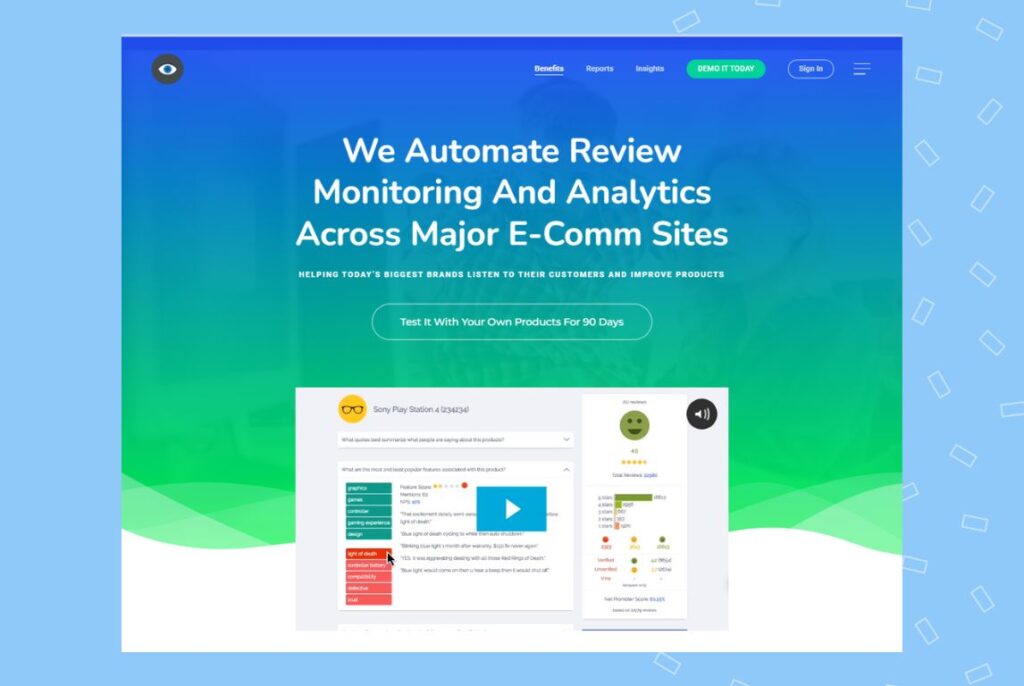
Review Monitoring uses machine learning and NLP to analyze data from 15+ retail sites. You can also monitor competitors, scale your business, and improve customer experience.
15. Mentionlytics
Mentionlytics is a reputation and review monitoring tool for businesses to track reviews on major review sites and respond to them from the tool itself.
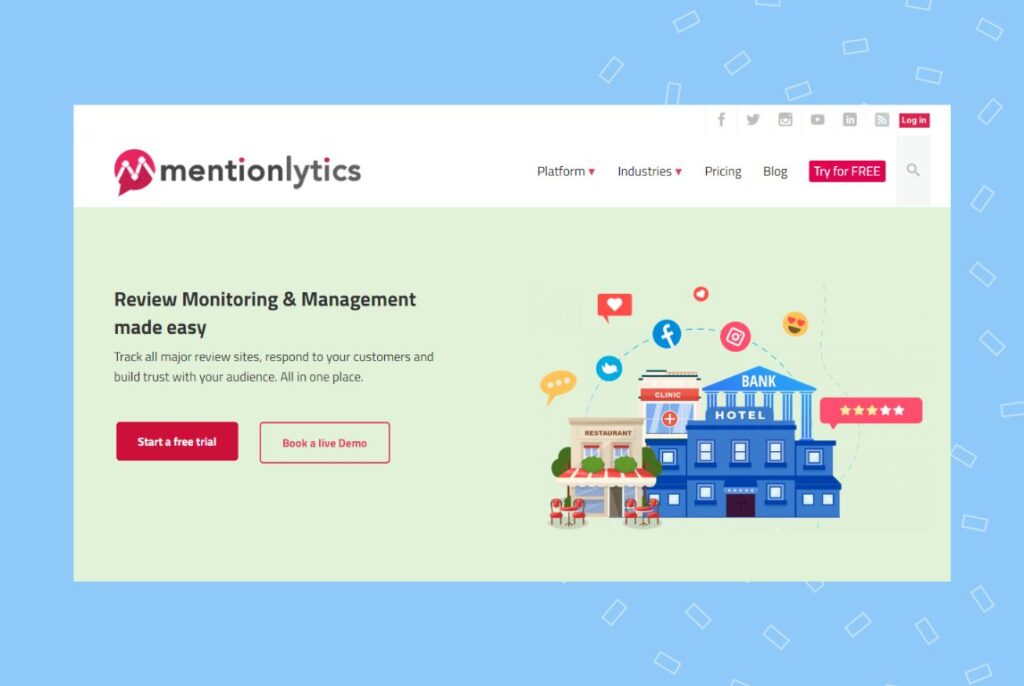
With this tool, you can:
- Monitor conversations and reviews across sites and social media platforms.
- Compare your performance against competitors.
- Share reviews on your social media platforms.
- Get alerts as soon as a new review comes in.
16. Hootsuite
Hootsuite is a social media scheduling and publishing platform that allows businesses to track brand mentions, keywords, and specific conversations on social media platforms. This is available as an add-on feature within Hootsuite and is known as Hootsuite Streams.
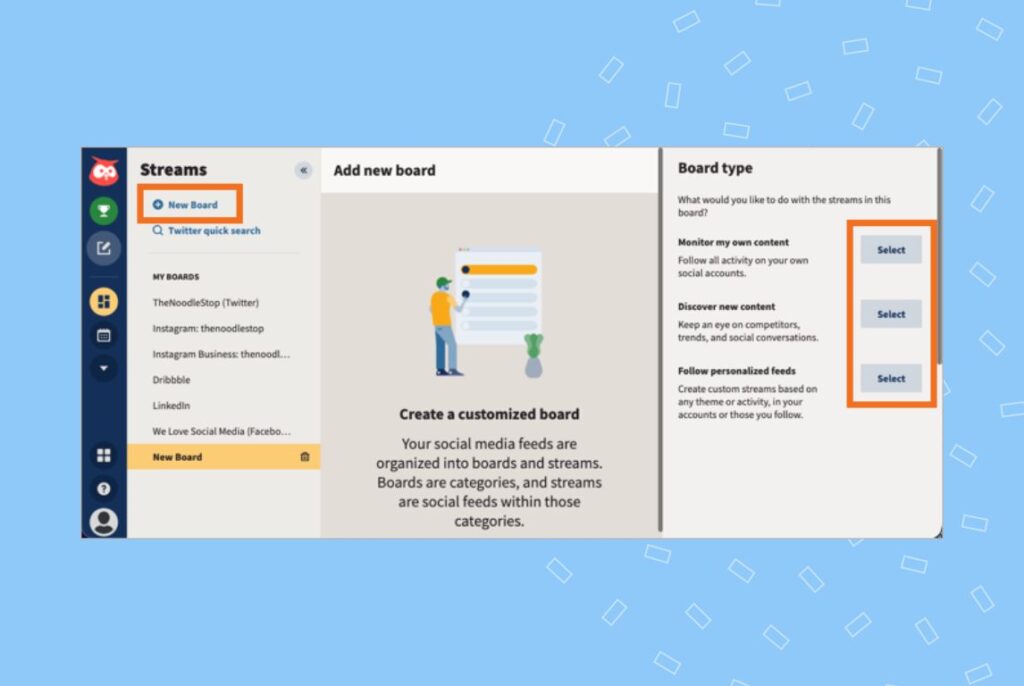
With Hootsuite Streams, you can create individual feeds/monitoring streams for your Facebook, Instagram, and LinkedIn business accounts. It can be a helpful review monitoring tool if most of your reviews come from social media mentions.
Review monitoring: A critical part of online reputation management
Review monitoring is a continuous, complex, and essential part of online reputation management. The more you know about brand perception and customer sentiment, the better you can scale your business. It involves constantly monitoring review sites, tracking keywords, brand mentions, and checking what customers say about your brand.
Frequently asked questions about review monitoring
Monitoring reviews helps businesses understand market sentiment, gauge customer satisfaction, identify opportunities and threats, and boost online reputation.
The process of monitoring your online image is called reputation monitoring, including review monitoring, social media monitoring, and listings management.
Monitor your reviews with Birdeye – the top-rated review and reputation management platform
Monitoring reviews across multiple review sites can be a challenge, especially for multi-location businesses. It becomes critical to monitor all customer reviews to manage them effectively. That is why a multi-location compatible review monitoring tool like Birdeye Reviews AI comes in handy,
Birdeye Reviews AI is a top-rated reputation management platform that allows you to generate reviews, manage them, monitor them, share them online, and analyze them with AI-assisted reporting features.
Step up your customer experience and online reputation with Birdeye Reviews AI.

Originally published
